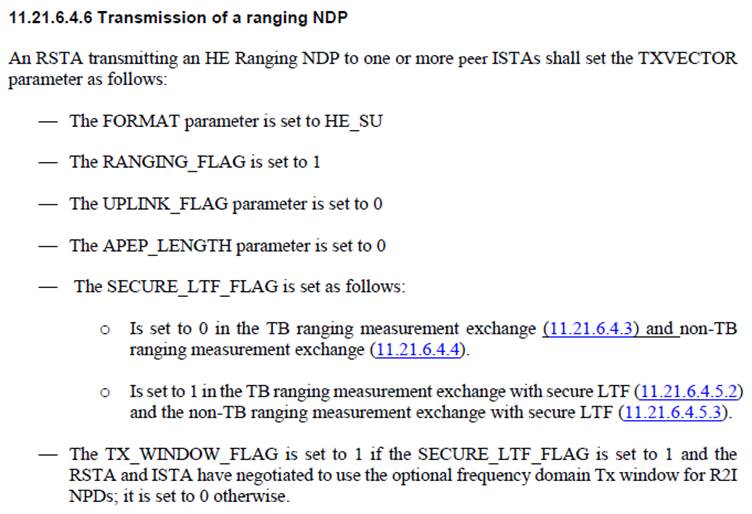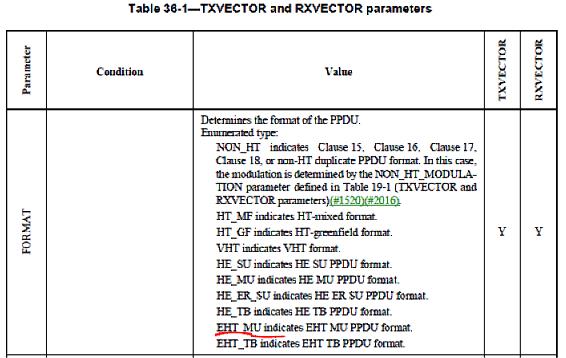Hi Chris:
Thanks for checking the .11 specs. I agree we could add a subclause “Transmission of an NDP for sensing” (some TXVECTOR parameters for NDP may be defined there) located in Clause 11 MLME. I will add this in the
revision.
Regards,
Yan.
From: Chris Beg [mailto:chris.beg@xxxxxxxxxxxxxxxxxxxx]
Sent: Thursday, January 27, 2022 1:16 PM
To: Rojan Chitrakar <rojan.chitrakar@xxxxxxxxxxxxxxxx>; Yan Xin <Yan.Xin@xxxxxxxxxx>; STDS-802-11-TGBF@xxxxxxxxxxxxxxxxx
Subject: RE: [STDS-802-11-TGBF] draft baseline PDT for "NDP format"
Hi Rojan,
Yes, I agree. I did find some relevant options in the other .11 specs that could maybe help us out.
For the HT/VHT sounding, I see text under 10.36 (NDP Sounding) which describes how the TXVECTOR parameters shall be set when transmitting an HT/VHT NDP for sounding (specifically 10.36.2
/ 10.36.6).
For the HE sounding, I also see text under 26 (HE MAC) which describes how the TXVECTOR parameters shall be set when transmitting an HE NDP for sounding (specifically 26.7.5).
Finally, for 11az, it looks like there is text added in the MLME section under the FTM procedure (11.21.6) which describes how the TXVECTOR shall be set for a ranging NDP.
Looking at the text, my feeling is section 11 (MLME) as included in Yan’s PDT may be the best place to describe the TXVECTOR parameters for the NDPs. It seems to closely follow what
was done for ranging. Perhaps if there are differences between the different PHY types, maybe we could have a subsection for each PHY like what was done for the HT/VHT NDP sounding in section 10.36?
A snip of the ranging NDP TXVECTOR definition is below. I don’t think we have enough details to fully describe all the TXVECTOR parameters yet, but what are your thoughts on putting
a placeholder in the PDT under section 11.x.x to include the TXVECTOR parameters? Perhaps we can call it “11.x.y.z – Transmission of sensing NDP”?

Thanks and regards,
-Chris
From:
stds-802-11-tgbf@xxxxxxxxxxxxxxxxx
stds-802-11-tgbf@xxxxxxxxxxxxxxxxx On Behalf Of Rojan Chitrakar
Sent: January 25, 2022 9:51 PM
To: Yan Xin <Yan.Xin@xxxxxxxxxx>;
STDS-802-11-TGBF@xxxxxxxxxxxxxxxxx
Subject: RE: [STDS-802-11-TGBF] draft baseline PDT for "NDP format"
Hi Chris,
If I may add, regarding TXVECTOR parameters related to NDP transmissions, they are PHY specific and each PHY has defined methods to specify the NDP. E.g., for EHT PHY, the FORMAT has to be EHT_MU and PSDU_LENGTH = 0 signals
an EHT Sounding NDP. HE/VHT have similar tables. In my opinion, what is unclear now in 11bf is how to specify the NDP format for each sequence, especially if 11bf defines a new Sensing NDPA.


Regards,
Rojan
-----Original Message-----
From: Yan Xin <0000181ed67b5ae9-dmarc-request@xxxxxxxxxxxxxxxxx>
Sent: Wednesday, January 26, 2022 3:03 AM
To: STDS-802-11-TGBF@xxxxxxxxxxxxxxxxx
Subject: Re: [STDS-802-11-TGBF] draft baseline PDT for "NDP format"
Hi Chris:
Thanks for sharing the questions.
For the case of 11az, HE ranging NDP uses 2x HT-LTF with 8 us symbol duration, which is a specific case of HE-LTFs (with alternative parameters GIs, 1x / 2x/ 4x). For 11bf, I think we need to have further discussion on
the parameters related to the NDP for sensing.
Thanks,
Yan.
-----Original Message-----
From: Chris Beg [mailto:chris.beg@xxxxxxxxxxxxxxxxxxxx]
Sent: Friday, January 21, 2022 6:03 PM
Subject: Re: [STDS-802-11-TGBF] draft baseline PDT for "NDP format"
This is an interesting point, one which I wouldn’t mind discussing a bit further to understand the limitations.
I agree that we already have multiple NDP types defined, and creating a new one is outside the scope. But, what about defining TXVECTOR parameters for which are used to transmit the existing NDPs. Is this something
we have flexibility to define, and if so, where would we define it?
Thanks and regards,
-Chris
________________________________________________________________________
To unsubscribe from the STDS-802-11-TGBF list, click the following link:
https://listserv.ieee.org/cgi-bin/wa?SUBED1=STDS-802-11-TGBF&A=1
________________________________________________________________________
To unsubscribe from the STDS-802-11-TGBF list, click the following link:
https://listserv.ieee.org/cgi-bin/wa?SUBED1=STDS-802-11-TGBF&A=1
To unsubscribe from the STDS-802-11-TGBF list, click the following link:
https://listserv.ieee.org/cgi-bin/wa?SUBED1=STDS-802-11-TGBF&A=1
To unsubscribe from the STDS-802-11-TGBF list, click the following link: https://listserv.ieee.org/cgi-bin/wa?SUBED1=STDS-802-11-TGBF&A=1